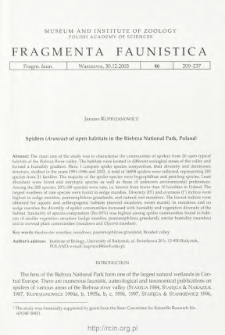- Search in all Repository
- Literature and maps
- Archeology
- Mills database
- Natural sciences
Advanced search
Advanced search
Advanced search
Advanced search
Advanced search

Object
Title: Spiders (Araneae) of open habitats in the Biebrza National Park, Poland
Creator:
Kupryjanowicz, Janusz ; Polska Akademia Nauk. Muzeum i Instytut Zoologii
Date issued/created:
Resource type:
Subtitle:
Fragmenta Faunistica, vol. 46, no. 2 ; Araneae of open habitats of Biebrza N. P. ; Pająki (Araneae) środowisk otwartych Biebrzańskiego Parku Narodowego
Publisher:
Museum and Institute of Zoology, PAS
Place of publishing:
Description:
Bibliogr. w "Errata to Number 2 of Volume 46 2003" ; P. 209-237 : ill. ; 25 cm ; Abstarct in Polish. Taxa in Latin.
Type of object:
Abstract:
The main aim of the study was to characterise the communities of spiders from 26 open typical habitats of the Biebrza River valley. The habitats were located in different ecological zones of the valley and formed a humidity gradient. Here, I compare spider species composition, their diversity and dominance structure, studied in the years 1991–1996 and 2002. A total of 56898 spiders were collected, representing 285 species from 21 families. The majority of the spider species were hygrophilous and peat-bog species. Least abundant were forest and eurytopic species as well as those of unknown environmental preferences. Among the 285 species, 20% (49 species) were rare, i.e. known from fewer than 10 localities in Poland. The largest numbers of rare species were found in sedge marshes. Diversity (H’) and evenness (J’) indices were highest in sedge marshes, psammophilous grasslands, and natural wet meadows. The lowest indices were obtained for aquatic and anthropogenic habitats (mowed meadows, sweet marsh). In meadows and on sedge marshes the diversity of spider communities increased with humidity and vegetation diversity of the habitat. Similarity of species composition (So>50%) was highest among spider communities found in habitats of similar vegetation structure (sedge marshes, psammophilous grassland), similar humidity (marshes) and in mowed plant communities (meadows and Glyceriamarshes).
Relation:
Volume:
Issue:
Start page:
End page:
Detailed Resource Type:
Format:
Resource Identifier:
oai:rcin.org.pl:54531 ; 10.3161/00159301FF2003.46.2.209
Source:
MiIZ PAN, call no. P.256, T. 46 nr 2 ; MiIZ PAN, call no. P.4664, T. 46 nr 2 ; click here to follow the link
Language:
Rights:
Terms of use:
Copyright-protected material. May be used within the limits of statutory user freedoms
Digitizing institution:
Museum and Institute of Zoology of the Polish Academy of Sciences
Original in:
Library of the Museum and Institute of Zoology of the Polish Academy of Sciences
Projects co-financed by:
Programme Innovative Economy, 2010-2014, Priority Axis 2. R&D infrastructure ; European Union. European Regional Development Fund
Access:
Object collections:
- Digital Repository of Scientific Institutes > Partners' collections > Museum and Institute of Zoology PAS > Scientific Journals
- Digital Repository of Scientific Institutes > Partners' collections > Museum and Institute of Zoology PAS > MIZ PAN Publications > Fragmenta Faunistica
- Digital Repository of Scientific Institutes > Literature > Journals/Articles
Last modified:
Feb 4, 2025
In our library since:
Jun 24, 2015
Number of object content downloads / hits:
1343
All available object's versions:
https://rcin.org.pl./publication/61154
Show description in RDF format:
Show description in RDFa format:
Show description in OAI-PMH format:
| Edition name | Date |
|---|---|
| Spiders (Araneae) of open habitats in the Biebrza National Park, Poland / Kupryjanowicz, Janusz | Feb 4, 2025 |
Objects Similar
Wolak, Maria Polska Akademia Nauk. Muzeum i Instytut Zoologii
Staręga, Wojciech Krzysztof (1939– ) Polska Akademia Nauk. Muzeum i Instytut Zoologii
Staręga, Wojciech Krzysztof Kupryjanowicz, Janusz Polska Akademia Nauk. Muzeum i Instytut Zoologii
Staręga, Wojciech Krzysztof (1939– ) Stankiewicz, Alicja Polska Akademia Nauk. Muzeum i Instytut Zoologii
Szymkowiak, Paweł Woźny, Marek Błażejczyk, Monika Polska Akademia Nauk. Muzeum i Instytut Zoologii
Sielicki, Marek Piotr Staręga, Wojciech Krzysztof (1939– ) Polska Akademia Nauk. Muzeum i Instytut Zoologii
Staręga, Wojciech Krzysztof (1939– ) Państwowe Wydawnictwo Naukowe (1951–1992) Polska Akademia Nauk. Instytut Zoologii

 INSTYTUT ARCHEOLOGII I ETNOLOGII POLSKIEJ AKADEMII NAUK
INSTYTUT ARCHEOLOGII I ETNOLOGII POLSKIEJ AKADEMII NAUK
 INSTYTUT BADAŃ LITERACKICH POLSKIEJ AKADEMII NAUK
INSTYTUT BADAŃ LITERACKICH POLSKIEJ AKADEMII NAUK
 INSTYTUT BADAWCZY LEŚNICTWA
INSTYTUT BADAWCZY LEŚNICTWA
 INSTYTUT BIOLOGII DOŚWIADCZALNEJ IM. MARCELEGO NENCKIEGO POLSKIEJ AKADEMII NAUK
INSTYTUT BIOLOGII DOŚWIADCZALNEJ IM. MARCELEGO NENCKIEGO POLSKIEJ AKADEMII NAUK
 INSTYTUT BIOLOGII SSAKÓW POLSKIEJ AKADEMII NAUK
INSTYTUT BIOLOGII SSAKÓW POLSKIEJ AKADEMII NAUK
 INSTYTUT CHEMII FIZYCZNEJ PAN
INSTYTUT CHEMII FIZYCZNEJ PAN
 INSTYTUT CHEMII ORGANICZNEJ PAN
INSTYTUT CHEMII ORGANICZNEJ PAN
 INSTYTUT FILOZOFII I SOCJOLOGII PAN
INSTYTUT FILOZOFII I SOCJOLOGII PAN
 INSTYTUT GEOGRAFII I PRZESTRZENNEGO ZAGOSPODAROWANIA PAN
INSTYTUT GEOGRAFII I PRZESTRZENNEGO ZAGOSPODAROWANIA PAN
 INSTYTUT HISTORII im. TADEUSZA MANTEUFFLA POLSKIEJ AKADEMII NAUK
INSTYTUT HISTORII im. TADEUSZA MANTEUFFLA POLSKIEJ AKADEMII NAUK
 INSTYTUT JĘZYKA POLSKIEGO POLSKIEJ AKADEMII NAUK
INSTYTUT JĘZYKA POLSKIEGO POLSKIEJ AKADEMII NAUK
 INSTYTUT MATEMATYCZNY PAN
INSTYTUT MATEMATYCZNY PAN
 INSTYTUT MEDYCYNY DOŚWIADCZALNEJ I KLINICZNEJ IM.MIROSŁAWA MOSSAKOWSKIEGO POLSKIEJ AKADEMII NAUK
INSTYTUT MEDYCYNY DOŚWIADCZALNEJ I KLINICZNEJ IM.MIROSŁAWA MOSSAKOWSKIEGO POLSKIEJ AKADEMII NAUK
 INSTYTUT PODSTAWOWYCH PROBLEMÓW TECHNIKI PAN
INSTYTUT PODSTAWOWYCH PROBLEMÓW TECHNIKI PAN
 INSTYTUT SLAWISTYKI PAN
INSTYTUT SLAWISTYKI PAN
 SIEĆ BADAWCZA ŁUKASIEWICZ - INSTYTUT TECHNOLOGII MATERIAŁÓW ELEKTRONICZNYCH
SIEĆ BADAWCZA ŁUKASIEWICZ - INSTYTUT TECHNOLOGII MATERIAŁÓW ELEKTRONICZNYCH
 MUZEUM I INSTYTUT ZOOLOGII POLSKIEJ AKADEMII NAUK
MUZEUM I INSTYTUT ZOOLOGII POLSKIEJ AKADEMII NAUK
 INSTYTUT BADAŃ SYSTEMOWYCH PAN
INSTYTUT BADAŃ SYSTEMOWYCH PAN
 INSTYTUT BOTANIKI IM. WŁADYSŁAWA SZAFERA POLSKIEJ AKADEMII NAUK
INSTYTUT BOTANIKI IM. WŁADYSŁAWA SZAFERA POLSKIEJ AKADEMII NAUK




































